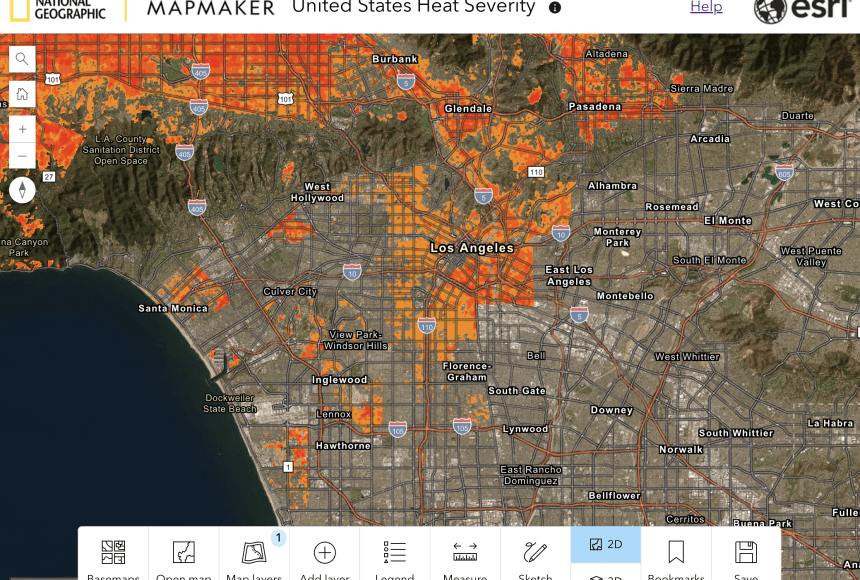Urban heat islands (UHIs) occur when parts of a city with highly concentrated infrastructure and little vegetation contain pockets or islands with hotter temperatures than surrounding rural or suburban areas. Concrete abundant urban neighborhoods can experience average temperatures that are 2.8-3.9°C (5-7°F) hotter during the day and 1.1-2.8°C (2-5°F) warmer at night than nearby, rural towns. Though regionally the sun’s heat and light reach urban, suburban, and rural areas in similar ways, local temperatures depend on how well each environment holds heat.
Heat islands commonly form in areas with highly concentrated infrastructure, dense populations, and sparse vegetation—all characteristics of urban regions.
- Infrastructure: Dark-colored structures like buildings and roads absorb and re-emit the sun’s heat. This causes heat islands to become pronounced even during cooler nighttime temperatures, as these structures slowly release the heat they absorbed during the day. Tall buildings and tight streets within a city can trap hot air and reduce airflow in a way that contributes to a structure’s ability to release heat.
- Human Activity: Air-conditioning units, vehicles, industrial facilities, and condensed areas with a lot of people all generate anthropogenic waste heat that can inflate the temperature difference between urban and outlying areas. Heat islands promote increased use of air conditioning, which can amplify energy use and produce more heat.
- Vegetation: The amount of vegetation affects the temperature of an area through a process called evapotranspiration. In this process, plants absorb water from the ground that is then converted into water vapor and released into the air. This acts as a natural air conditioner, as water vapor lowers surface and air temperatures. Vegetation can also help lower high temperatures by providing shade.
Urban heat islands impact the environment through impaired water quality. Urban heat islands experience reduced water quality from rainwater flowing over hot, impermeable surfaces like rooftops and paved roads. This heated water carries heavy metals, trash, bacteria, and other pollutants, to drain through sewers and into natural bodies of water to cause minor temperature changes. These changes can cause accelerated bacteria and algae growth, which can upset an aquatic ecosystem and further diminish local water quality.
Urban heat islands can also have negative health effects for many populations including older adults, young children, low-income populations, people who work outdoors, and people with pre-existing health conditions. All of these populations are susceptible to extreme heat and can cause a variety of health issues if not paid attention to. For example, young children are susceptible to extreme heat due to their rapid breathing rates relative to their small body size. This increases the chance for their respiratory systems to become aggravated and develop asthma. Low-income populations are also at a greater risk of heat-related illnesses due to poor housing conditions and inadequate resources to stay cool and hydrated.
How can we reduce urban heat islands?
- Planting trees around the city and along paved streets lowers surface and air temperatures by providing shade and cooling through evapotranspiration.
- Reduce energy consumption by performing maintenance and staying aware of your air-conditioning unit. Replacing disposable air filters, turning your air-conditioning fan to auto, and cleaning debris around your air conditioning unit are some easy ways to keep energy usage low. Preventing indoor heat gain also reduces energy consumption because your air-conditioning won’t need to work as hard to regulate a set indoor temperature. A few ways you can prevent indoor heat gain are to shade windows that receive a lot of sunlight, paint your walls a lighter color, and keep all windows and doors tightly shut.
- Reduce energy consumption by turning off your air-conditioning, lights, and ceiling fans when it is safe to do so. This will reduce energy consumption that would otherwise be used to power these appliances for no reason.
- Green roofs are plants, shrubs, grasses, or trees grown on a rooftop. Doing this helps reduce the temperatures of roof surfaces and the surrounding air. Green roofs can also reduce water runoff and thus improve water quality by filtering and absorbing rainwater as it falls.
- Cool roofs are made of coatings or materials that reflect heat and sunlight away from a building. Installing one could lower energy costs and cool the building, making it more comfortable for its occupants.
- Cool pavements are composed of newer paving materials that reflect more solar energy, increase the rate of water evaporation, and allow newer sidewalks and streets to remain cooler than traditional pavements. Working to replace conventional pavements with cool pavements could dramatically reduce the temperature in more severe urban heat islands.
This map layer demonstrates the distribution of urban heat islands by severity on a scale of one to five, where one represents a relatively mild heat area (slightly above the city’s average temperature) and five marks a severe heat area (dramatically above the city’s average temperature). This map layer was produced by Descartes Labs. During the summer of 2021, a satellite with a thermal sensor measured the temperature of the surface of Earth in 30-meter by 30-meter boxes, called cells or pixels. When temperatures from 2021 weren’t available, the data was patched with measurements from the previous summer. Experts then used computers to calculate the average temperature for each cell over the United States. For the cells over urban areas, they compared the average temperature to those over suburban and rural areas nearby then assigned the appropriate value (1-5) on the urban heat severity scale. This type of data set, where a matrix of cells or pixels is organized into rows or columns, is called a raster.
